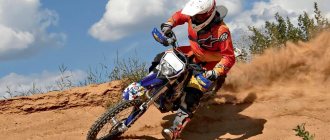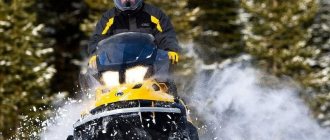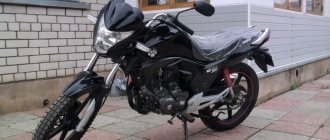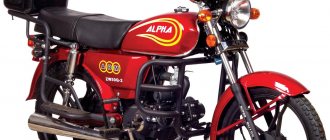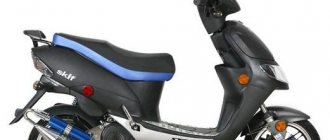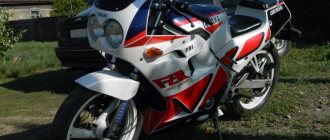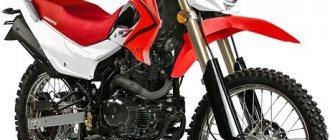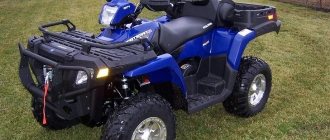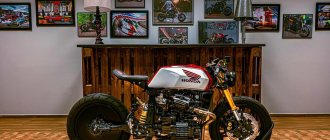000_moto_1211_038
The world's popular class of pit bikes - small cross-country motorcycles with 4-stroke "Cab" engines - has finally come to us. Moreover, during this delay two important events occurred. Firstly, Chinese motorcycle manufacturers took over their production and significantly reduced prices. But the most important thing is that with their help the class has evolved. After all, classic pit bikes (dating back to the Honda CRF50) on 10-inch wheels are, frankly speaking, too small. And the “filling” there is artificially archaic - drum brakes and a 3-speed gearbox. This type of device is offered in the Western markets by Honda, Yamaha, Kawasaki, and Suzuki.
Today, cars from the Middle Kingdom are imported into our country, not constrained by the traditions of pit bikers. They are cheaper than the “brand” ones and, moreover, a little larger, with modern “disc wheels” and more advanced suspensions. A noticeable share among them is occupied by the “Clip” of “Cartridges”, which is offered by the Ural Motorcycle Company. Three models are built on one platform (with a 125 cc engine) - for cross-country, enduro and motard on road tires. The last two options are with lighting devices and an electric starter. In principle, they could be driven on the roads if they came with a title. And so they fall into the category of sports cars and are cheaper for the buyer.
The basis of the devices is the “Kab” engine, which is “inflated” here to 125 cm³ - the limit that the standard crankcase allows (for more information about these engines, see “Moto” No. 12–2009). An aluminum lined cylinder is used (in small-capacity models it is cast iron), a head with more developed fins. The clutch is like on motorcycles, “manual”. There are 4 gears in the box, however, the order in which they are engaged is specific: when accelerating, everything goes down.
Frame, seat, tank, wheels - everything is larger than on classic pit bikes. Motorcycles are not only suitable for children over 10 years old, but they can also accommodate adults. True, the weight is nominally limited to 75 kg, but this is if the motos are used for their intended purpose - for “annealing”. There is a caveat for very young children: they must ride under the supervision of a trainer. After all, the power of these cars is not at all childish - under 10 “forces”.
The suspension is quite advanced - in the front there are adjustable inverters for rigidity, and in the rear there are motor shock absorbers. Wheels with aluminum alloy rims and pendulums with lever systems are offered as tuning options.
The most sophisticated version is the Motard version: in addition to the light, ignition switch and electric starter, it is possible to move the steering wheel back and forth to optimize the landing. Accordingly, the price is higher.
Well, let those for whom these motorcycles are intended tell you about their riding impressions.
Roman Vakhrushev (14 years old):
I train in the motocross section of the Izhevsk sports school. We ride old two-stroke Pilots. I rode the Patron Cross 125 for the first time in today's training session. The “Chinese” suspensions work much better, the engine is much more powerful, and it looks cool. After this training, our school is going to switch to these cross-country shoes. Although I have little racing experience, I hope that I will achieve success on the new motorcycles.
Nikolay Mashchak (11 years old):
I've been doing motocross for several years. I train and compete on my KTM-65SX. This year I went to championships in different federal districts, and ended up in 6th place. When I was invited to test new motorcycles, I thought it would just be photography. But some guys we knew from a motorcycle school came, we got excited and started racing for real.
Although I love my KTM, I really liked the Chinese motard. It turns out that the 4-stroke engine is great, you don’t have to switch frequently. My two-stroke has six gears, but here there are only four, but they are enough. Of course, the tires on a motard are not designed for intersections; it’s better to drive around the city with them (though I can’t do it yet - I don’t have “licenses”). But you can still race on these tires - during the shooting the guys couldn’t catch up with me, although their bikes were on motocross tires. If the track is dry, then the motard has a chance, but I wouldn’t compete in wet conditions.
The rear suspension seemed rather weak to me, although I weigh 30 kg. True, we did not specifically regulate them. There are no complaints about the front end. The steering wheel is optimal for my height - not wide and not high.
MOTORCYCLE PATRON JUNIOR 125 MOTARD
Displacement: 123.6 cc.
Power: 6.3 kW (8000 rpm)
Torque: 8.8 Nm (5500 rpm)
Features:
improved air filter, 428 chain, reinforced front wheel hub, updated rear monoshock, engine protection, battery protected from damage
COMMON DATA:
Motorcycle wheelbase (distance between wheel axles): 1200 mm.
Length: 1750 mm.
Width: 740 mm.
Height: 1130 mm.
Frame type: spinal, steel pipes, stamped welded
Weight (dry): 78 kg.
Maximum load: 75 kg.
Maximum speed: 80 km/h.
Fuel consumption (control, after running in standard conditions):
— on the highway: no more than 2.8 l/100 km.
— in the city: no more than 4.0 l/100 km.
Let the brake at a speed of 30 km/h: no more than 7 m.
ENGINE:
Type: CUВ,154FMI, 4-stroke, single-cylinder, air-cooled
Cylinder displacement: 123.6 cc.
Power system: Mikuni carburetor
Piston diameter and stroke: 54.0x54.0 mm.
Power: 6.3 kW (8.6 hp)/8000 rpm.
Max. torque: 8.8 Nm/5500 rpm.
Geometric compression ratio: 9,2:1
Starting system: electric and kick starter
Lubrication system: oil pump
Ignition system: contactless, capacitor
Fuel: gasoline with an octane rating of at least 92
Oil: four-stroke engine oil SAE10W/40
Intake valve clearance: 0.05-0.07 mm.
Exhaust valve clearance: 0.05-0.07 mm.
POWER TRAIN, CHASSIS:
Drive type: mechanical, with four-speed gearbox, KMS Gold chain
Gear sequence: N-1-2-3-4
Chain transmission ratio: 38/15=2,533
Clutch: multi-plate, oil bath, manual release
Front suspension: telescopic fork with inverted spring-hydraulic shock absorbers
Rear suspension: pendulum fork with spring-hydraulic monoshock absorber
Front tire size: 120/70 -14
Rear tire size: 120/70-14
Brakes, type (front/rear): disc/disc
ELECTRICAL EQUIPMENT:
Battery: 12 V, cap. 4 Ah.
Generator: flywheel, alternating current, permanent magnet
Fuse: 15 A
Spark plug: NGK C7HSA
Headlight low/high beam: 12 volts, 35W/35W
Tail light: LED
017_moto_1211_038
RESULT. All three “Patrons” are school desks in their respective disciplines. There is plenty of engine power for a children's motorcycle, so young drivers have the opportunity to learn how to “spend all their money” before switching to more serious equipment. Given the lack of a vehicle license, this vehicle is prohibited from entering the road, but “rights” are not needed either. Thus, these motorcycles are destined to live in the outdoors, and for this the motocross and enduro are best suited.
| TECHNICAL SPECIFICATIONS (manufacturer's data) | |||
| Model | Patron Junior Cross 125 | Patron Junior Enduro 125 | Patron Junior Motard 125 |
| COMMON DATA | |||
| Model year | 2011 | ||
| Length/base, mm | 1800/1200 | ||
| Dry weight, kg | 70 | 75 | |
| Seat height, mm | 840 | 820 | |
| Ground clearance, mm | 300 | ||
| Gas tank volume, l | 5,0 | ||
| ENGINE | |||
| Type | 1-cyl., 4T | ||
| timing belt | ONS, 2 valves per cylinder. | ||
| Working volume, cm³ | 123,6 | ||
| Dimension, mm | 54×54 | ||
| Compression ratio | 8,8:1 | ||
| Max. power, hp at rpm | 9,3/8000 | ||
| Max. torque, Nm at rpm | 9,0/5000 | ||
| Supply system | Mikuni carburetor | ||
| Cooling system | air | ||
| Starting system | kickstarter | electric and kickstarter | |
| TRANSMISSION | |||
| Clutch | multi-disc in oil bath | ||
| Transmission | 4-speed | ||
| main gear | chain | ||
| CHASSIS | |||
| Frame | steel spatial | ||
| Front suspension | inverted telescopic fork | ||
| Stroke, mm | 190 | ||
| Rear suspension | monoshock absorber | ||
| Stroke, mm | 130 | ||
| Brake system | separate, hydraulic | ||
| Front brake | disc, 2-piston caliper | ||
| Rear brake | disc, 1-piston caliper | ||
| Front tire | 70/100–17 | 120/70–14 | |
| Rear tire | 90/100–14 | 120/70–14 | |
Motorcycles for the test were provided by the Izhevsk Ural Motorcycle Company.
Ice cream for the kids? No, "Cartridges"!
Patron Junior 125 Motard
Working
volume : 123.6 cc. Max.
power: 6.3 kW (8000 rpm) Max. torque: 8.8 Nm (5500 rpm) Pit bike is a compact and lightweight motorcycle, a smaller copy of the classic full-scale “cross bike”. Thanks to its low weight and low seat height, the pit bike is easy to control, forgives many piloting mistakes and is an excellent tool for active recreation and amateur motorsports for both adult riders and older children and teenagers. The scope of application of a pit bike is extremely diverse: motocross, enduro, supermoto, stunt riding, etc. A pit bike is also good for amateur rides in the vicinity of your favorite dacha. Having a low cost, compact dimensions, excellent handling and a peppy engine, a pit bike allows you to get a lot of positive things and can become an excellent alternative to an expensive “adult” sports motorcycle.
The line of pit bike class motorcycles offered consists of three modifications (CROSS/ENDURO/MOTARD) of the Patron Junior 125 model. All of them are equipped with an impressive four-stroke engine with a displacement of 125 cc, but differ from each other in a number of details:
The “Motard” modification differs from the “Enduro” model in the front and rear wheels with a road tread pattern with a diameter of 14 inches. Its main purpose is to train beginner athletes in the supermoto class, practice elements of stunt riding, as well as receive a lot of positive emotions and a hefty dose of adrenaline from dynamic riding on routes closed to traffic.
Based on the results of long-term road tests, sports competitions and motocross training, all three modifications were significantly modernized in 2013 in order to improve their performance and eliminate identified shortcomings and comments. The changes affected the geometric dimensions and strength of wheel hubs and wheel bearings, the dimensions and service life of sprockets and chains, energy intensity and protection from damage by stones and dirt of the rear shock absorber, dimensions, location and protection from accidental damage to the air filter. These and a number of other improvements made it possible to raise the consumer properties of pit bikes to an even higher level.
Motorcycle KTM 125 EXC Enduro 1999 review
Description of the KTM 125 EXC Enduro 1999 motorcycle is in the queue for publication of the article. Announcement: Today, for almost every new motorcycle that comes into being, marketers strive to carve out their own niche. This one is a road sport, this one is a recreational enduro. But what class should we include a motorcycle that has a little bit of everything? A good bike should have a reliable engine, comfortable ergonomics and simple controls...
KTM 125 EXC Enduro is a very rare motorcycle in Russia equipped with a low-power 11 hp engine. Despite the fact that good models of motorcycles have a very respectable price, and the season for their use is relatively short, the motorcycle market is developing rapidly. And if you believe the words of dealers, then some models of recently released motorcycles are selling like hot cakes at the beginning of the season, and the models brought to Russia are clearly not enough to fully satisfy consumer demand.
A motorcycle has long ceased to be an alternative to a car, and the times when this equipment was bought only because there was not enough money for a full-fledged car are forgotten. Nowadays, two-wheelers can be called technological marvels in many cases, and their cost can be compared with that of prestigious cars.
Many people have started buying motorcycles for hobby purposes as riding or even collecting them has become a good pastime for many people. Many motorcycles, for example the KTM 125 EXC Enduro, whose technical characteristics allow the model to be called a prestigious brand, are in demand among both beginners and experienced motorcyclists.
Currently, it is impossible to purchase a new KTM 125 EXC Enduro motorcycle from the 1999 model year, since their production stopped 17 years ago. At the same time, the KTM 125 EXC Enduro has excellent technical characteristics, so many people strive to purchase, if not a new, then at least a used version.
Motorcycles with an engine capacity of 124 cc. see, appeared as a result of long work of inventors who sought to create a model that was not inferior in characteristics to other versions of the motorcycle. In some cases, these models are not only not inferior, but also ahead of other motorcycles, as they have minimal fuel consumption and other excellent parameters.
Go to the entire range of KTM motorcycles, on this page you can find KTM 125 EXC Enduro motorcycles from other years of production and information about them
1.9.3.2.1. 5.6 mm rimfire cartridge
1.9.3.2.1. 5.6 mm rimfire cartridge
It is one of the most important for the production of small fur-bearing animals.
Previously, sporting and hunting cartridges with a steel sleeve were usually used for commercial hunting, and more recently “Junior-S” cartridges, which, thanks to the steel sleeve, can be used in the temperature range from –50° to +50 °C. In 1992, the Klimovsky Stamping Plant, which produces these cartridges, proposed five new cartridges: three cartridges with an expansive bullet and initial velocities Vo=315, 370 and 410 m/s and two cartridges with a non-expansive bullet with initial velocities Vn=370, 410 m/s . The use of an expansive bullet and new gunpowder in the design of the cartridge, which ensures its high speed, made it possible to obtain a cartridge with increased lethal effect.
It should be noted that the pressure of powder gases in high-velocity cartridges does not exceed 1300 kgf/cm?, i.e., similar to the pressure that develops in the barrel when firing serial Junior cartridges.
Table 19
Technical characteristics of 5.6 mm rimfire cartridges
| Type of cartridge | Bullet weight, g | Highest maximum pressure of powder gases, kgf/cm? | Bullet speed, m/s | Bullet energy, J | ||||
| V0 | V50 | V100 | E0 | E50 | E100 | |||
| "Junior" | 2,6 | 1300 | 328 | 296 | 270 | 140 | 113 | 95 |
| With an expansive bullet | 2,4 | 1300 | 315 | 265 | 235 | 119 | 84 | 64 |
| With an expansive bullet | 2,4 | 1300 | 370 | 330 | 300 | 167 | 132 | 105 |
| With a non-expansive bullet | 2,6 | 1300 | 370 | 325 | 254 | 177 | 137 | 110 |
| With an expansive bullet | 2,4 | 1300 | 410 | 340 | 300 | 202 | 139 | 108 |
| With a non-expansive bullet | 2,6 | 1300 | 410 | 345 | 305 | 219 | 155 | 121 |
The technical characteristics of the cartridges are given in table. 19
.
At the request of consumers, cartridges can be supplied in a regular or “northern” version (shooting at low temperatures) and in various packaging (moisture-proof bags for 500 rounds, metal sealed boxes for 3000 rounds, as well as a combination of these packages).
Currently, organizations that have the appropriate permits can order, in addition to the serial “Junior” and “Sniper” cartridges, high-precision sports cartridges “Temp” and “Biathlon”, as well as the best cartridges in the world today, “Olympus rifle” and “Olympus” -BI" (biathlon). They are distinguished by high shooting accuracy, including at sub-zero temperatures, increased wind resistance of the bullet in flight, as well as sealed design, which makes the cartridge ideal for efficiency when hunting small fur-bearing animals. Previously, Olympus cartridges were produced in limited quantities and only on orders from USSR national teams.
